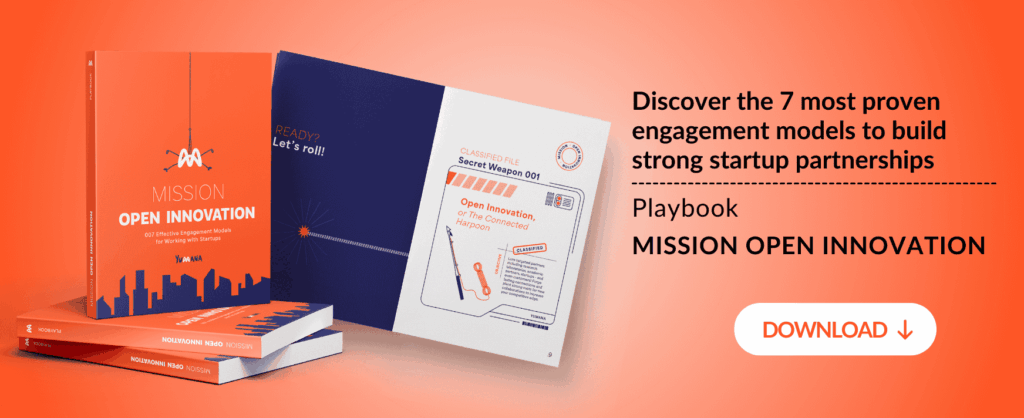Innovation cycles are accelerating, knowledge is becoming hyper-specialized, and user needs are evolving far beyond the boundaries of the enterprise. In the face of such growing complexity, no organization can claim to innovate alone anymore.
Collaborating with an external ecosystem is no longer optional. It’s a natural and strategic extension of any ambitious innovation process.
Startup scouting is a model that’s increasingly embraced and proving its worth. By identifying and activating targeted partnerships with innovative startups, it enhances an organization’s ability to explore, experiment, and transform.
Let’s take a closer look at the benefits, methods, and levers behind an effective scouting strategy!

Startup Scouting: An Agile Method for Spotting and Engaging High-Potential Startups
Startup scouting goes far beyond simple monitoring: it’s a process that enables companies to identify relevant startups, assess them, and align them with concrete business priorities, ultimately translating this into strategic partnerships, investment opportunities, or acquisitions.
Two complementary approaches often coexist: a targeted strategy to meet a specific need, and a broader exploration to capture weak signals, uncover emerging uses, or scout underexplored areas of innovation.
Its strength? Initiating fast, focused collaborations without getting locked into heavy processes. Unlike incubators or equity investments, scouting opens doors without prematurely tying up resources. It’s an agile, modular lever that adapts to project maturity and internal pace.
Overview of the Main Collaboration Models with Startups:
| Approach | Main Goal | Timeframe | Engagement Level |
|---|---|---|---|
| Startup Scouting | Identify high-potential players | Short term | Light / exploratory |
| Corporate Accelerator | Support the growth of a startup | Mid-term | Medium / partnership |
| Corporate Incubator | Co-develop a startup from its inception | Long term | High / structural |
| Innovation Challenge | Solve a specific problem with external input | Short term | Variable / mobilizing |
| Corporate Venture Capital (CVC) | Invest in strategic startups | Long term | High / financial |
| Client Venturing | Test solutions with a strategic client | Short/mid-term | Medium / operational |
Startup scouting offers a wealth of benefits: by identifying high-potential solutions or disruptive signals early, it helps anticipate market shifts and seize opportunities before they become mainstream, while reducing the risk and effort of innovation.
It can also enhance internal projects by providing complementary technologies or expertise. Most importantly, it fosters a new mindset by creating hybrid ecosystems that drive digital transformation and new organizational models (test-and-learn, collaborative dynamics, learning culture).
Six Key Steps to Structuring an Effective Startup Scouting Process
1 – Ground the Process with Clear, Measurable Objectives
It’s essential to define clear exploration parameters: Which markets or technologies should be targeted? What maturity level is required—proof of concept, commercial stage, scale-up?
Should the focus be on specific regions or business verticals? This initial framing ensures relevant scouting outcomes and alignment with the company’s broader transformation goals.
2 – Multiply Entry Points to Spot the Right Signals
The strength of a scouting initiative lies in the diversity of its sources. Sector-specific databases, specialized events, calls for projects, unsolicited applications, investor networks, local incubators, and thematic communities all bring unique perspectives.
Tools like Crunchbase or Pitchbook provide a first-sector mapping to identify trends, track funding rounds, and gain a global view. More advanced platforms like Tracxn or CB Insights add analytical layers (scoring, dynamic tracking, advanced filters), enabling deeper, more targeted exploration.
3 – Choose the Right Tools to Manage and Qualify Startups
Once your sources are active, the ability to structure, filter, and prioritize information becomes essential. That’s where tools come in, falling into three main categories:
- Automated Scouting uses predefined keywords or filters to scan large databases. It’s fast and effective for simple searches but struggles to detect nuanced positioning.
- Contextual Scouting via LLMs (Large Language Models) analyzes large volumes of content (websites, interviews, open databases) to extract meaningful insights. This method captures informal signals like founders’ language, strategic intent, or points of differentiation.
- Hybrid Scouting combines automation with human analysis. Platforms like Novable offer an AI-generated shortlist enriched and validated by analysts. This model balances processing power and contextual insight while remaining tailored to specific needs.
Each method has its own strengths in terms of speed, depth, or customization potential.
Comparison of Scouting Tools
| Approach | Strengths | Weaknesses |
|---|---|---|
| Automated Scouting |
|
|
| Contextual Scouting (LLMs) |
|
|
| Hybrid Scouting (AI + human) |
|
|
Tool selection should align with innovation strategy maturity, opportunity volume, and internal resources.
4 – Involve Internal Teams in Evaluation and Selection
At Yumana, we believe in using collective intelligence to qualify scouted startups as part of an open innovation program. We’ve built a hybrid model where employees can evaluate and document a shared repository, test use cases, and recommend relevant partners. Startups can then join internal projects for co-development! This is a powerful way to engage internal stakeholders in the scouting process and foster a culture of best practices and knowledge sharing.
5 – Turn Scouting into Collaboration
To deliver real impact, scouting must lead to concrete activation initiatives: calls for projects, internal incubators, client venturing programs… It should also align with existing investment levers (corporate funds, CVCs…) to support selected startups.
The goal: test quickly, fund if needed, and embed partners into project roadmaps through co-development with internal teams.
6 – Anticipate Common Pitfalls
Pitfalls to avoid include launching without a clear strategic objective, working in silos, failing to build on past experiments, or overlooking internal sponsors who help prioritize. An effective program requires fluid governance and solid oversight.
Real-World Examples: Successful Startup Scouting Strategies
At Leroy Merlin, a scouting program built around the Novable platform allowed for targeted startup detection in the housing sector, aligned with on-the-ground operational needs. The program identified tangible solutions, kickstarted pilot programs, and shaped strategic thinking around smart homes and new customer services.
BMW’s Startup Garage exemplifies scouting embedded in tech partnerships. Startups aren’t treated as one-off suppliers but as co-development partners for high-value components. The selection process is rigorous, but the collaboration is designed for long-term impact.
Toward Enhanced, Purpose-Driven Startup Scouting
Startup scouting is evolving into a broader vision of innovation. Four major shifts are reshaping its scope:
1 – Scaling Through Automation and AI
AI is transforming scouting practices. Automation enables continuous analysis of massive data flows (funding, patents, publications, web signals…) to identify emerging startups faster. AI-driven platforms now deliver tailored scouting from a strategic brief using qualitative criteria (keywords, intent, tech fit), refined by learning algorithms.
The result: greater speed, deeper insights, and better detection of weak signals. AI doesn’t replace human judgment. It amplifies it by freeing time for interpretation, fine-grained qualification, and relationship-building.
2 – Making Impact a Core Selection Criterion
More and more companies are adding non-financial metrics to their evaluation grids. This “impact scouting” considers not just economic or tech performance, but also contribution to global challenges: ecological transition, inclusion, responsible governance. It means revising indicators, adopting new frameworks, and involving diverse profiles in selection. Scouting becomes a lever for both innovation and engagement.
3 – Opening Up to Previously Overlooked Ecosystems
Rapidly growing ecosystems are emerging across Africa, Latin America, and Southeast Asia, home to clever, frugal, and locally rooted solutions. Exploring these regions fosters a listening mindset, broadens the horizon, and offers inspiration from models that are increasingly relevant beyond their local markets.
4 – Becoming an Attractive Partner for Startups
A reverse trend is taking shape: startups are now selecting the corporates they want to work with. They assess clarity of processes, execution ability, and partner mindset. For corporates, this means sourcing is no longer enough: they must attract. This shift changes the rules of the game.
These dynamics such as impact, openness, and attractiveness, are redefining scouting. It becomes a strategic differentiator, a broader lens on the world, and a way to align technological exploration with social responsibility.
Conclusion
Startup scouting is far more than a monitoring tool. It’s a strategic lever that empowers companies to look ahead, connect with innovators, and experiment with agility.
In a constantly evolving world, building bridges with external innovation is crucial. Through scouting, companies do more than identify solutions. They forge collaborations that harness the best of both worlds: the vision and innovation capacity of startups to move faster and smarter, and the stability of the organization to scale impact through shared value creation.
It’s not over yet!
What if you had, right in your hands, the detailed blueprint for building truly effective collaborations with startups?
Yumana shares its expertise and dozens of successful client missions in a highly actionable and immersive playbook.
What’s inside? The top 007 engagement models to roll out startup collaboration strategies that are solid and aligned with your business goals:
Startup Scouting, Innovation Challenge, Open Innovation Program, Corporate Accelerator, Corporate Open Data, Venture Clienting and Corporate Venture Capital.
Each model comes with: real-life case studies, field-tested tactics and common pitfalls to avoid to help you structure your next operations with agility.
Discover the 70-page reference to be fully equipped for your Mission: Open Innovation!

CEO & Co-Founder Yumana



